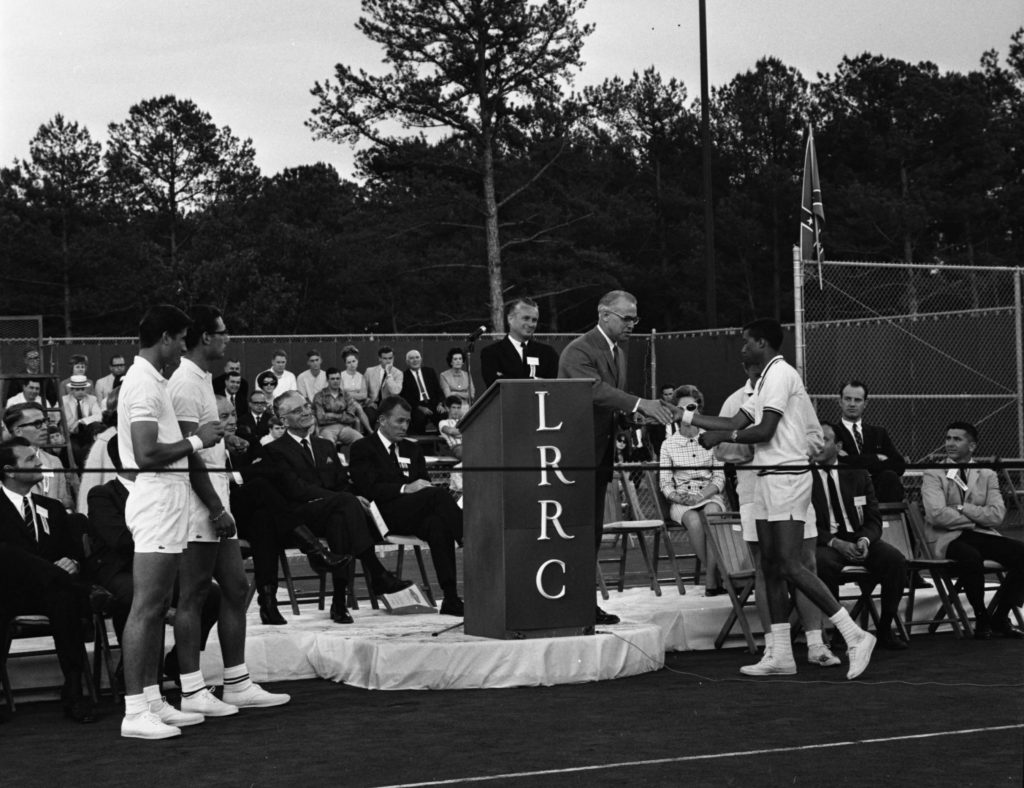By Acadia Roher
I have been staring at, investigating, developing metadata, and writing about photographs in the Earl Saunders, Jr. photo collection for seven months now and still find myself startled by what I didn’t notice until the tenth or eleventh pass. Perhaps because photographs are ubiquitous in our daily lives (there are at least 500 on my phone right now), I often fail to take in every detail and what each tells us about a moment in time. How could I have missed, for example, the Confederate flag flying prominently from a fencepost at the Little Rock Racquet Club in this photo of Arthur Ashe serving to Cliff Richey, his 1967 U.S. Davis Cup teammate?

It wasn’t just the players. Winthrop Rockefeller, Governor of Arkansas at the time, stood smiling under the same flag to cut the ribbon for the club’s dedication ceremony. Mayor Martin Borchert shook hands with Ashe, Richey, and their teammates before the same backdrop. Other photos show that the audience was entirely white. What should we make of this?

Sports facilities have long been battlegrounds for racial equality. Growing up in Richmond, Virginia under Jim Crow, Ashe had many stories about the conditions in which he learned to play tennis and lived his life as a Black boy. Ashe wrote in Days of Grace about both “the kindly white tennis official who would not allow me to play in municipal tournaments, and all the other not-so-kind officials who barred my way.”
Yet he pushed on. “To me and my family,” Ashe wrote, “winning a place on our national team would mark my ultimate triumph over all those people who had opposed by career in the South in the name of segregation.” After gaining a spot as the first Black man on the U.S. Davis Cup Team, a position he held for 16 years, Ashe came to Little Rock for the exhibition game under fluttering American and Confederate flags that Earl Saunders, Jr. captured on film.
And what of the public officials? Governor Rockefeller was no stranger to facing white supremacy. In fact, he’d won the Governor’s race less than a year before on a tidal wave of African American support bolstered by civil rights activism and voter registration drives. He had prevailed against arch-segregationist opponent Jim Johnson, but in truth, Rockefeller was a moderate who opposed the Civil Rights Act of 1964 and avoided discussing civil rights on the campaign trail. He had spent the spring of 1967 pushing ambitious legislative reforms focused on the minimum wage, education, road infrastructure and safety, jury reform, and relaxed gambling and liquor laws. Rockefeller had also begun quietly increasing the numbers of Black Arkansans on various boards and commissions, advisory councils, and in higher ranking government jobs.

A newlywed and new statesman, Rockefeller stepped onto the tennis court on May 9th under the Confederate flag with Ashe smiling behind him. Less than a year later he would be standing arm in arm with civil rights leaders on the steps of the Arkansas State Capitol after the assassination of Martin Luther King, Jr. as “the only southern governor to hold a public memorial service in King’s honor.”
Yet he would subsequently call out the Arkansas National Guard to occupy Black neighborhoods and quell protests that erupted after the brutal death of 18-year-old Curtis Ingram at the Pulaski County Penal Farm.
Rockefeller’s legacy on civil rights turned out to be a mixed bag and he faced increasing criticism from the Black community, particularly in his second term. He was guilty of the same white moderate foot dragging that King called out in his “Letter from Birmingham Jail.” “They keep saying, ‘Go slow!’” Nina Simone echoed in her provocative masterpiece “Mississippi Goddam.”

At the time of his Little Rock visit, Ashe admired heroes like Muhammed Ali and John Carlos “from the social and racial remove of the almost entirely white, upper-class stratum” of the tennis world. His memoir is rife with regrets about his latecomer activism. “Dressed in immaculate white, I was elegantly stroking tennis balls on perfectly paved courts” he wrote, while “young men and women of my age were enduring pain and suffering so that blacks would be free.” Ashe was trained to be “unfailingly polite on the court, unfalteringly calm and detached, so that whites could never accuse me of meanness,” but he lived every day with the dissonance bubbling beneath the surface.
Ashe saw himself primarily as an entertainer, a “modern counterpart to minstrels.” Black men had always been permitted within white spaces, so long as they were in the position of servant or spectacle. It is thus unsurprising that Ashe played beneath a Confederate flag for a white audience in Little Rock while simultaneously persisting, thriving, and building the footing to eventually step into social justice work.
Ashe dedicated himself to anti-apartheid activism with vigor following his retirement from tennis. He also catapulted into the AIDS movement after USA Today broke the news that he had contracted the syndrome from a blood transfusion during heart surgery in 1983. With his immune system compromised, Ashe died of pneumonia ten years later in 1993. Years of conflict erupted around the plan to place a statue of Ashe on Richmond’s Monument Avenue, otherwise a memorial to white supremacy and the “Lost Cause.” There are ongoing campaigns to remove the Confederate statues, but I suspect Ashe is there to stay.
For more information:
Ashe, Arthur and Arnold Rampersad. Days of Grace: A Memoir. New York: Alfred A. Knopf, 1993.
Kirk, John. “Swimming against the tide of desegregation in Little Rock.” Arkansas Times. February 6, 2014. https://www.arktimes.com/arkansas/swimming-against-the-tide-of-desegregation-in-little-rock/Content?oid=3199765
“Race-Tinged Furor Stalls Arthur Ashe Memorial” New York Times. July 9, 1995. https://www.nytimes.com/1995/07/09/us/race-tinged-furor-stalls-arthur-ashe-memorial.html
Stockley, Grif. Ruled by Race: Black/White Relations in Arkansas from Slavery to the Present. Fayetteville: University of Arkansas Press, 2008.
Urwin. Cathy Kunzinger. Agenda for Reform: Winthrop Rockefeller as Governor of Arkansas 1967-71. Fayetteville: University of Arkansas Press, 1991.